Objective: Design an academic semester planner that follows the student's journey through the weeks of school. The planner aims to allow students to practice purposeful and intentional planning to practice Executive Functioning (EF) skills.
Result: EF it to ACE it planner creates a new academic planner that gives the students a friendly introduction to creating new and healthy habits through intentional monthly, weekly, and daily academic planning. A special quote a day keeps the planning and education expectations real and honest with self-care and love in mind.
Introduction
EF it to ACE it is an academic planner focusing on weekly semester progress versus traditional annual planners. The planner includes self-care and mental health reminders to assist in practicing executive functioning (EF) skills. The use of the planner, when used consistently and intentionally, allows students to practice EF skills, such as time management, self-awareness, organization, planning, memory, problem-solving, and flexibility - to name a few.
The challenge and personal experience
Student life can come with many new challenges. One of the biggest things a student must learn quickly is how to manage their new life. This could mean a new city, new roommates, new living arrangements, and in addition to that, the college experience. This is only the beginning of starting college life.
A large part of this project stemmed from my personal experience of being a student with many self-expectations. I was wrapping up my junior year at University but still had so much learning I wanted to do. I decided to add two minors to my major and pack on the classes. The excitement drove me to get more organized and stay organized so I could keep my focus at a maximum high. I was already doing some planning for school but not consistently and not well. I knew that had to change that with my newly added responsibilities so I sat down and planned out my future - the next semester.
My planning habits from previous years helped me progress into becoming more aware of what I was capable of handling. When I look back at my random and messy planning notes and planners, it gave me insights into how I could improve my work habits and recreational habits. The notes offered me a more realistic view of time and how I used it. Visually seeing what I had planned at different weeks of the semester allowed me to see my progress and how much I was able to accomplish week by week.
The excitement drove me to get more organized and stay organized so I could keep my focus at a maximum high.
This opportunity to look back and review my semester through planning gave me flashbacks of the exact time and mental space I was in within that moment in time. I remembered the lighter weeks compared to the heavier workload weeks because of my planning and this led me to remember the pains of long days on campus with longer overnight shifts to get that forgotten assignment in or that bit of study cramming I had to do because I didn't do it. I wanted to avoid as much dread and loss of sleep as much as possible so then I sat down and made the ultimate plan for my future.
The following semester, I signed up for a full semester plus more. In addition to that, I challenged myself to take on an elective I knew was out of my comfort zone. I also held a work-study position doing 10-15 hours a week. Most of my weeks looked the same but for me, it was comforting to visually see where my time was going and how I was using it. There were times and days when things didn’t go as planned but this was also a space for problem solving and flexibility. The idea of the planner is that your day and your plans are not set in stone and it shouldn’t always have to be that way. I learned along the way that life is inevitable and things will not go your way all the time. The planner gave me the time and space to see where flexibility was possible. The planning that I was doing was to help me build a foundation of what my day could look like, and what I could expect by having a routine. I learned along the way that planning is also flexible, planning is freedom, planning is independent.
The planning that I was doing was to help me build a foundation of what my day could look like, and what I could expect by having a routine. I learned along the way that planning is also flexible, planning is freedom, planning is independent.
Supplies and devices I used for planning: washi tape for decoration, colored markers and highlighters, pens, graphing paper, sketchbook, Apple iPad Pro with Apple Pencil.
Getting started
a. The initial idea The original concept was to design a weekly planner that is clean, crisp, and created for design students. There was going to be a certain aesthetic to it that spoke to design students, students who were in the arts. That was the only idea behind it and of course, it would become a tool to help students practice executive functioning skills through planning. My audience was specific and it was a smaller group of students.
b. Discovery and shared ideas Three main ideas were discussed throughout the discovery process with designers and journal/planner users. They are, as listed below:
C. Research The questions above gave me plenty more to consider when creating and designing a useful planner for a wider audience of students. How could I accommodate the larger audience? Where did my priorities lay? My research led me to explore through sketching, creating, and recreating, and coming back to people for their input and their critique. I reassessed the purpose of the planner and used design thinking to reimagine the planner.
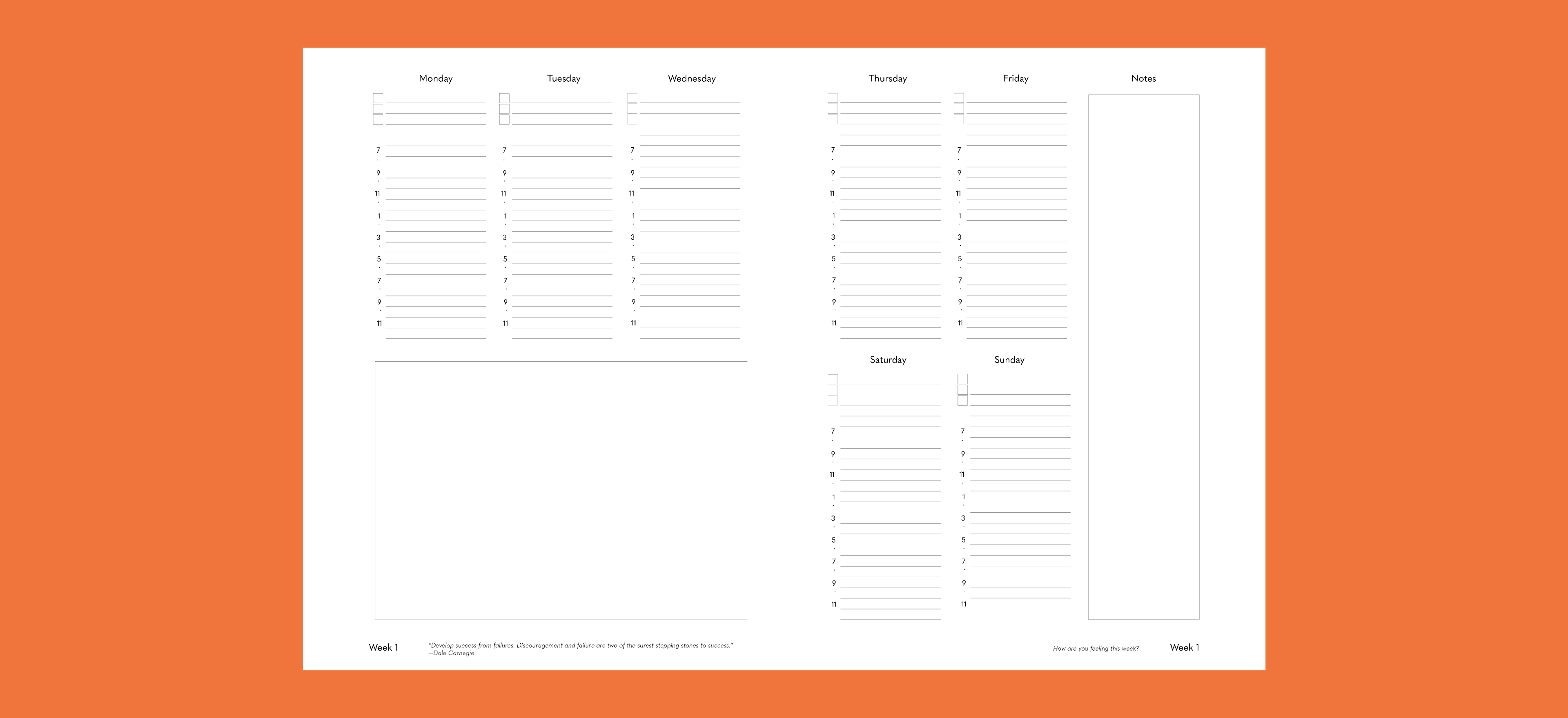
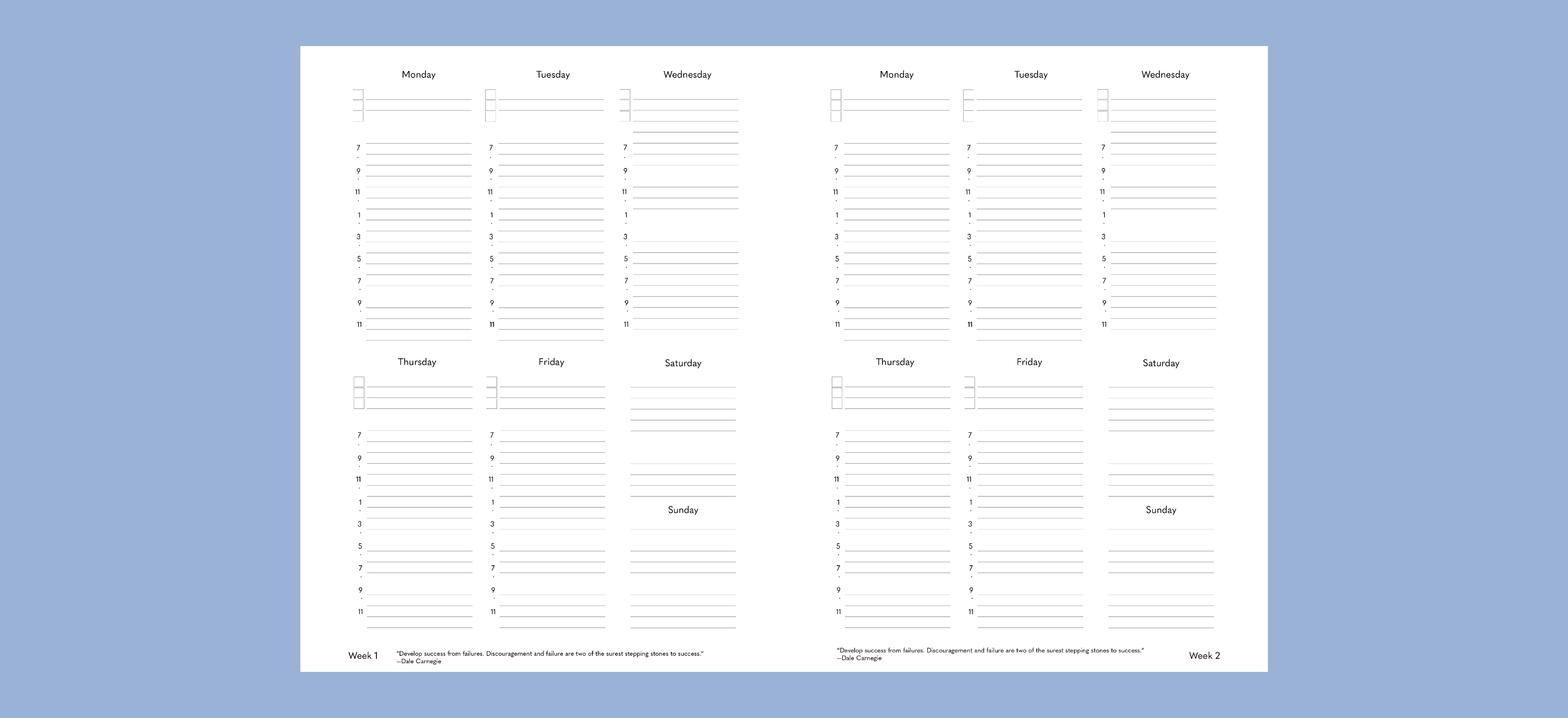
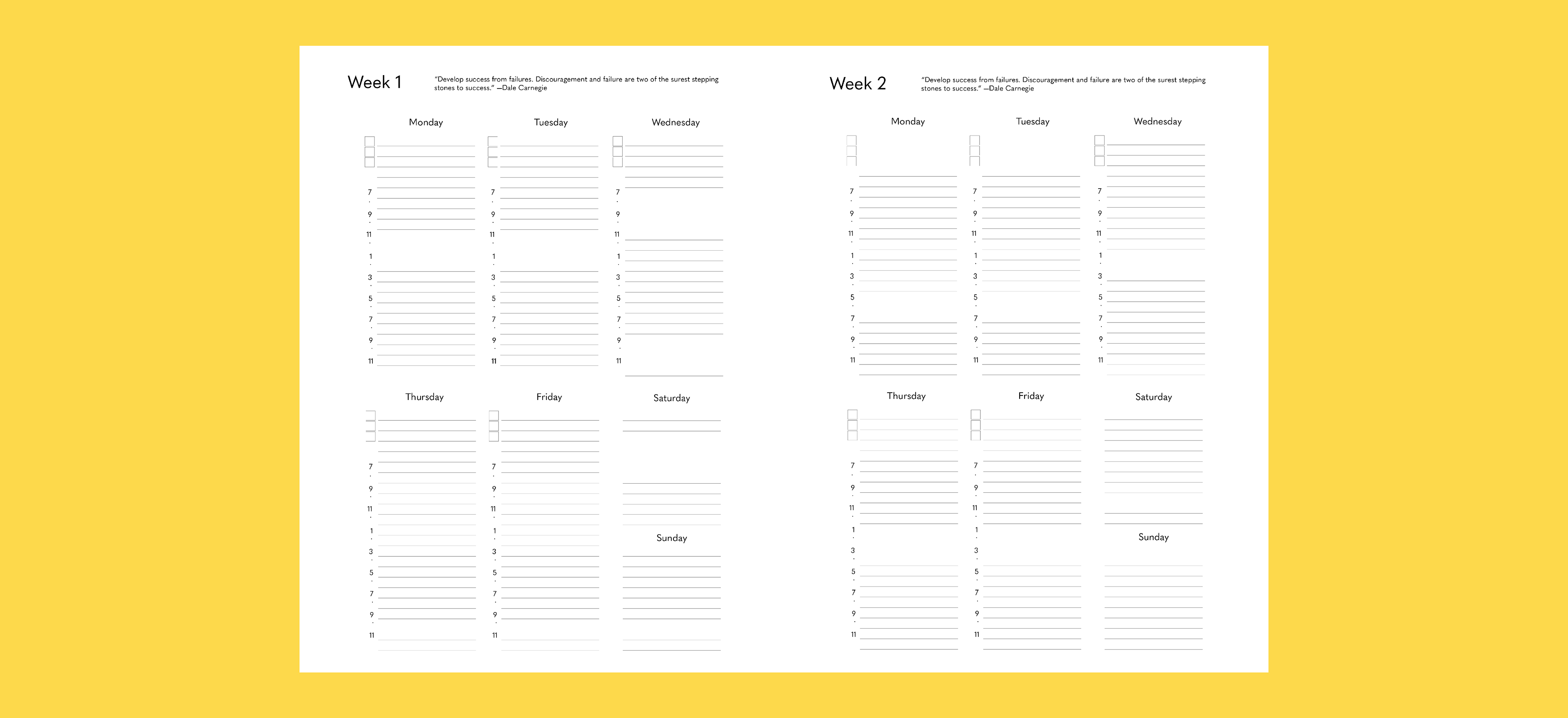
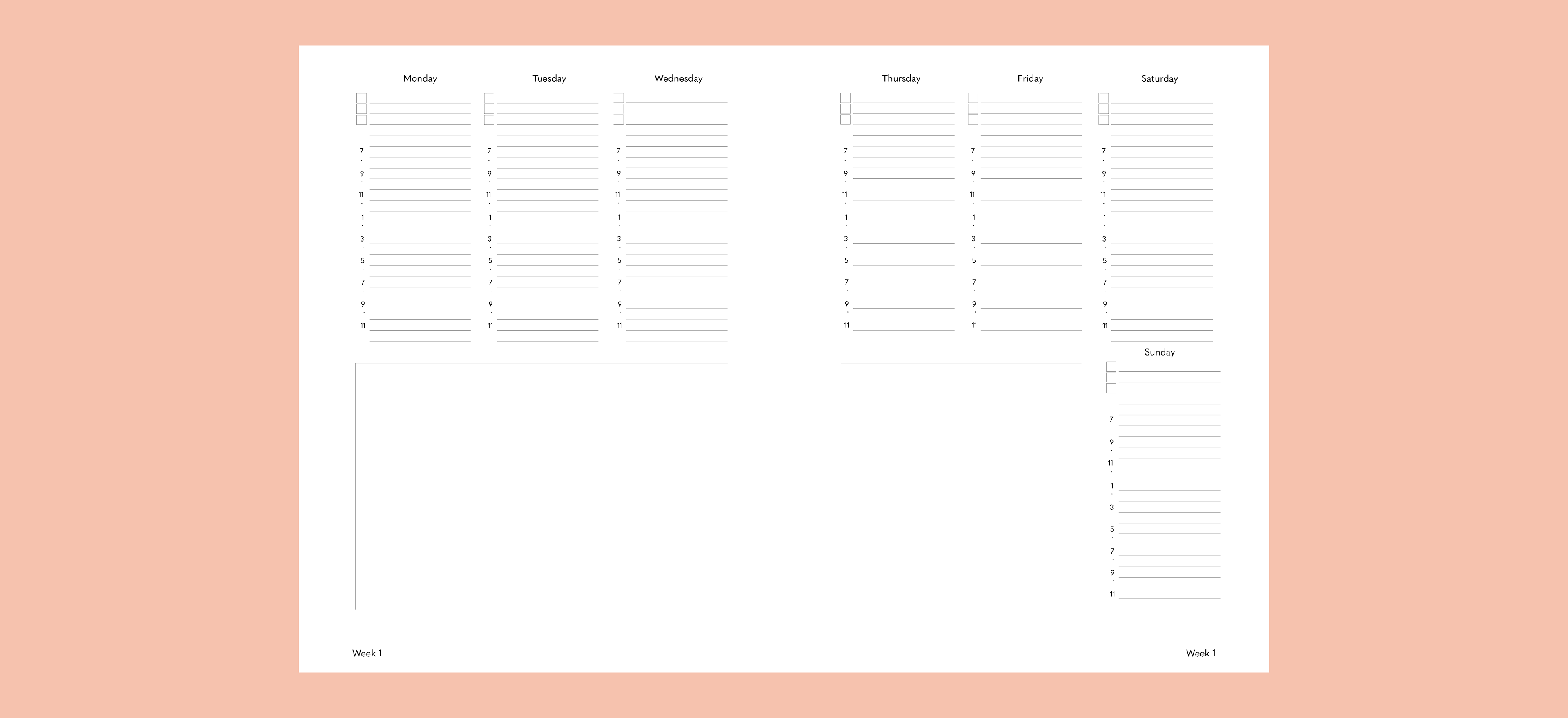

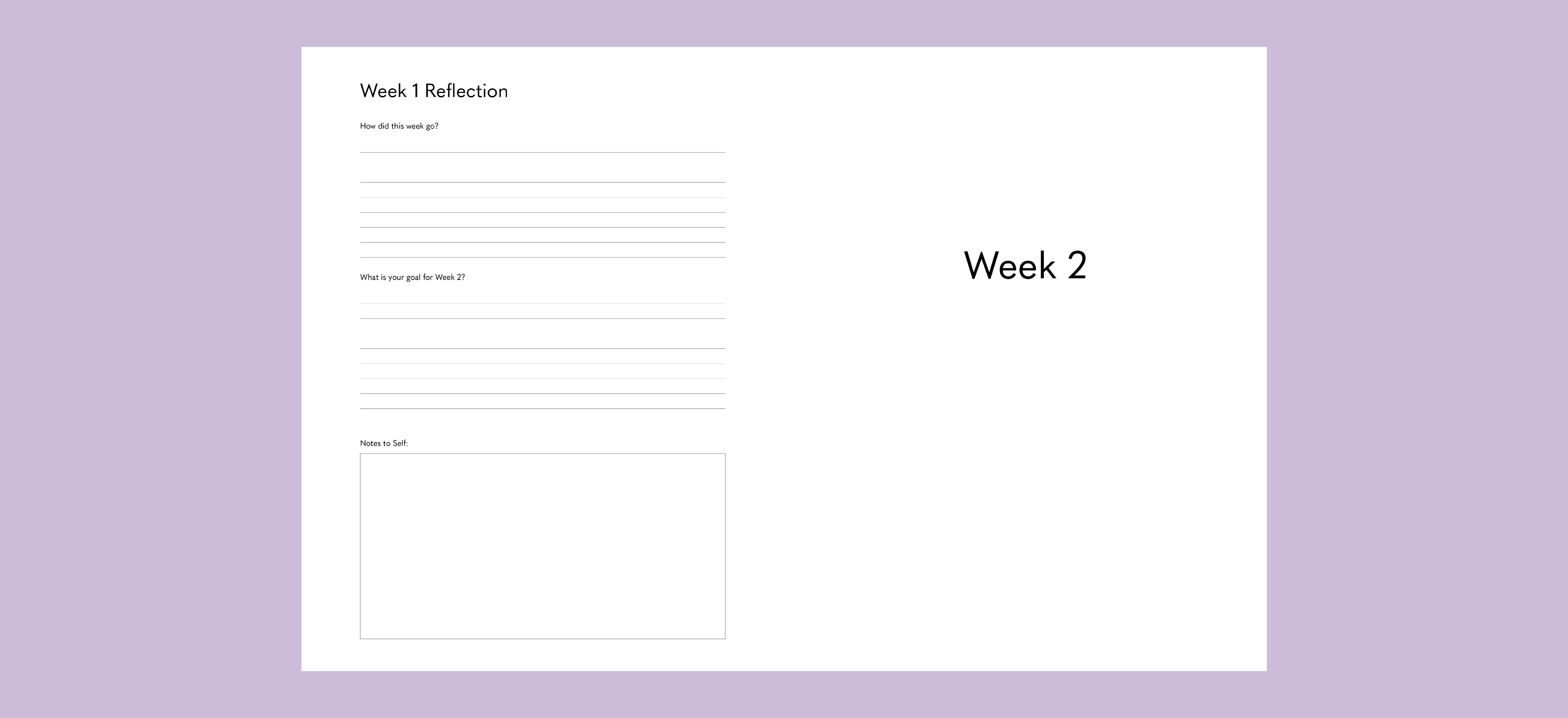
First Drafts of layout templates for the Weekly Spread
The Redefined Objective
A. Offer a space for students to see their semester through intentional visualization of their time: from months to weeks, to days, and to the hour.
B. This space is for practice, for progress, for self-care and awareness, and for flexibility.
c. The planner is created for the user to work on creating habits for progression and success.
D. The planner's usage is customizable.
E. For the user to put Executive Functioning Skills to use.
Solution and Process
a. planner
1. The planner will be a focused academic planner that emphasizes the semester in weeks versus months. Many academic planners are annual planners that have a focus on monthly progress and goals. We will differentiate ourselves by focusing on weekly progress.
2. The planner will include self-care and self-affirmation quotes as a reminder to students that their health is just as important, or even more important, to attain a forward-moving, progressive semester. Self-health can determine how a student participates in their studies. Our goal is to ensure students are aware they come first - in mental health, physical health, and confidence.
3. The planner will use design elements to create a welcoming environment to encourage the use of the planner. Planners that are blank and clean can come off as intimidating. A blank page is too clean or too nice to ruin - we are here to give you some color to start the planning practice.
4. The planner's usage is customizable. We give you a foundation to plan your semester and your goals but the user can add more wherever they would like. The white space in the planner has been placed carefully for the user to doodle, place stickers, create a plan of movies to watch, or do meal planning, it is open to whatever the planner would like to do.
5. For the user to put Executive Functioning Skills to use.
b. Design
1. The layout will be welcoming and spacious. The pages included in the planner: Weekly, Daily, Breakers, Monthly Overview, Semester Overview, Resource Page, Important Dates, Fall Schedule
2. There will be colors that encourage positive and calm emotions. The psychology of colors will be used to reference the ideal color palette for the planner.
3. The planner will implant intentional and motivational quotes daily to bring self-awareness of mental health to the user as well as encouraging quotes to remind the student they are not alone and they are capable.
4. The size of the planner will easily blend in with their current school supplies so it doesn't feel bulky or get lost in the piles of books, notebooks, sketch pads, and devices.
5. Stickers will come with the planner to create more interaction with the planner for creativity and allow for customization to personalize the planner.
The final planner design
a. Semester Academic planner
1. The final planner includes important semester dates at the beginning of the planner. When these dates are easily accessible for students, they can use the listed dates to better plan their semester regarding their classes, financial aid, and holidays.
2. The monthly overview calendars are numbered by week to help students visualize which week they are in the semester.
3. The weekly spreads have the number of the week in the semester labeled at the top. The weekly spread has intentionally left blank date slots for students to fill out to help with tracking time and dates within the semester.
4. There are Weekly Goal Setting pages at the end of each week. This is a self-reflection to help the student think about their week and how they've used their time. This will assist in planning for the next week and making changes and adjustments as needed to accommodate school, life, and work.
5. The Daily Spreads have quotes or self-affirmation on each page to encourage self-health awareness. There is a space for daily reflection and/or daily creativity. The students can use this space however they want.
6. The Daily Spreads come with an hourly breakdown of the day. This practice of planning the day by hour can give the students a visual representation of what they do in a day, or how they spend their days. This is also a great place to determine how flexible you can be or if you should need to take some time for yourself.
B. Design
1. The layout is welcoming and spacious with appropriate white space to help the eyes focus on one area at a time.
2. The color palette is playful, vibrant, comfortable, and welcoming. Each week is a new color - there are six colors in the palette that get rotated. Having each week be a different color helps the student with the awareness that they are in a new week compared to the previous week.
3. The page breakers are obvious and bright. Each breaker has the dates of the week printed on the front with a space for the students to label it however they would like.
4. The layout has been tested and designed with intent and purposeful flow for the students to move through the pages seamlessly.
C. Stickers
1. The Self Care Stickers are to remind students that part of their day is to think about themselves and their basic needs. New users to planners might find it funny to plan when to eat, where to eat, or even then to nap but it is extremely important to consider those basic needs to be a part of your day and your time.
2. Spring Break stickers are created for students to happily slap on a CARE WEEK for themselves to allow for some well-deserved relaxation.
